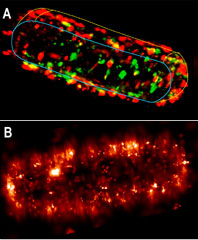February 21, 2018
Teng-Leong Chew to present Biochemistry and Molecular Biophysics Seminar on Feb. 22
Submitted by Biochemistry and Molecular Biophysics

Teng-Leong Chew, director of the Advanced Imaging Center at Howard Hughes Medical Institute at Janelia Research Center, will present "Imaging life with the new frontiers in spatial and temporal resolution" as part of the Biochemistry and Molecular Biophysics Seminar series at 4 p.m. Thursday, Feb. 22, in 13 Leasure Hall.
Chew received his doctorate at Saint Louis University studying the role of myosin II regulation in endothelial cells. As a postdoc, he worked with Rex Chisholm at Northwestern University developing fluorescent biosensors to simultaneously monitor the enzymatic activity and localization pattern of myosin light chain kinase in vivo. In 2002, Chew became the director of the Center for Advanced Microscopy at Feinberg School of Medicine at Northwestern University, and in 2009 became the director for University Imaging Resources at Northwestern University. He joined Janelia Farms in 2014 as the director of the Advanced Imaging Center.
One of the reasons for his visit is to inform K-State faculty of opportunities to visit the Advanced Imaging Center for super-resolution microscopy of samples of interest. See the PDF abstract of his talk. The center specializes in super-resolution microscopy, including interferometric photoactivatable localization microscopy, or iPALM; also called stochastic optical resolution microscopy, or STORM. In these techniques, researchers employ special photoactivatable fluorophores that intermittently "blink" instead of continually emitting light after excitation. Photoactivatable fluorophores allow incredible clarity of the labeled molecules, allowing single-molecule resolution. Biochemistry and molecular biophysics researchers were fortunate to visit the Advanced Imaging Center last November to collect super-resolution images of the E. coli cell envelope, shown in the image. The resolution is sufficient to see individual molecules, in this case the outer membrane proteins FepA — orange —and Omp F — orange — and the inner membrane protein TonB — green.
If you'd like to meet with Chew to discuss your research, please contact Phillip Klebba at peklebba@k-state.edu about available opportunities.
